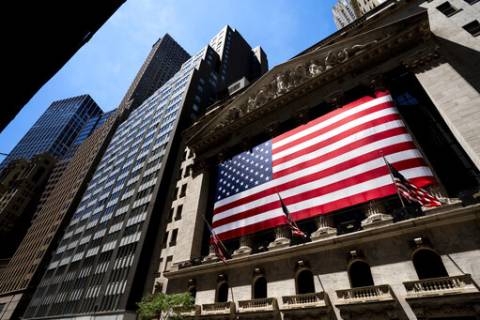NEW YORK (AP) — U.S. stocks are drifting between gains and losses Tuesday as Wall Street debates whether the market’s strong recent run is the start of a turnaround or a temporary blip.

The S&P 500 was 0.2% lower in afternoon trading after earlier swinging between a loss of 0.9% and a gain of 0.5%. The Nasdaq composite was leading the market with a 0.2% gain, as of 2:55 p.m. Eastern time, but a sharp drop for equipment maker Caterpillar helped drag the Dow Jones Industrial Average down by 265 points, or 0.8%, to 32,532.
Treasury yields climbed through the day as concerns calmed a bit that the first visit by a U.S. Speaker of the House to Taiwan in 25 years could cause a conflict between the world’s two largest economies.
Stocks have held relatively steady this week after spurting in July to their best month since late 2020. It was a rare winning stretch for the market, which has struggled this year under worries about the highest inflation in 40 years and rising interest rates from the Federal Reserve to combat it.
Some weak recent data on the economy raised speculation that the peak for inflation and for the Federal Reserve’s aggressive hikes to interest rates may be approaching or has already passed. The weak data, though, also shows the risk of a recession as rate hikes already pushed through by the Fed put the brake on the economy.
A report on Tuesday showed that U.S. employers posted fewer job openings in June, and the number was weaker than economists expected. A lot rides on whether the job market can remain resilient. It’s been helping to prop up the economy as inflation tears into the finances of households across the country.
On Friday, a report will show how many workers U.S. employers added last month, and economists expect it to show the unemployment rate remains very low even as hiring slowed.
More support for Wall Street recently has come from stronger-than-expected corporate profits for the spring. On Tuesday, rideshare company Uber surged nearly 18% after it reported stronger revenue than analysts expected.
The better-than-expected reports so far this earnings season have helped the S&P 500 climb nearly 12% since hitting a low in mid June. Such rallies of more than 10% have historically been common within long-term down markets, though more sharp drops can quickly follow them. Such “bear market rallies” occur an average of about 1.5 times during each bear market, which is what Wall Street calls a long-term drop of 20% or more for stocks, strategists wrote in a BofA Global Research report. Savita Subramanian wrote in the report that she is sticking with her year-end target of 3,600 for the S&P 500, which implies a further 12% drop.
One discouraging signal for investors came Tuesday from a profit report by Caterpillar, seen by some on Wall Street as an economic bellwether. Its stock tumbled 5% after the Illinois-based maker of backhoes and bulldozers reported weaker revenue for the latest quarter than analysts expected.
Much of Wall Street’s focus Tuesday was also focused across the Pacific Ocean on U.S. House Speaker Nancy Pelosi, whose plane touched down in Taiwan a little after trading began in New York. Her visit ratchets up tensions with China, which claims Taiwan as its own and quickly announced it would conduct military maneuvers in retaliation for her presence.
The worry in financial markets is that tensions could boil over, leading to blockages in international trade. China and Taiwan are together the source of half the semiconductor chips consumed by the world “and almost all of the latest high-tech chips,” High Frequency Economics chief economist Carl Weinberg wrote in a report.
Treasury yields fell in the morning with the worries but recovered as the day progressed. The 10-year yield rose to 2.74% from 2.61% late Monday.
___
AP Economics Writer Paul Wiseman contributed.
